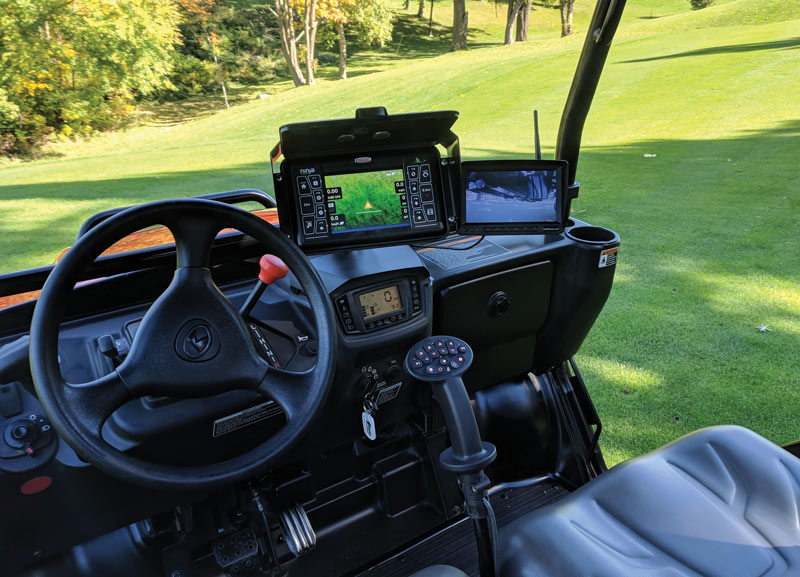
The precision afforded by GPS technology can be an answer to many of the challenges facing the golf industry, from budget and labor constraints to the need to conserve resources and minimize environmental impact. Shown above, an ARAG Ninja full GPS sprayer control at Wayzata (Minn.) Country Club. It automatically turns nozzles on and off to spray only the areas that have been mapped. Photo courtesy of Ken Rost
Bruce Gregory, CGCS, remembers the way it used to be — until three letters of the alphabet changed everything.
“About 40 years ago, I was in my first job out of college. Went back home to a nine-hole course,” says Gregory, a 22-year GCSAA member who oversees Liberty (Ind.) Country Club. “They were spraying greens out of the back of a pickup truck. A kid in the back was stirring up the chemicals with a canoe paddle, and they were pumping out the spray through a garden hose.”
My, how times have changed.
“I’ve seen the new sprayers they have now. They’re pretty sweet,” Gregory says. “I don’t have one. But would I use it? Absolutely. And I’m an older guy now.”
The golf course management industry, driven by modernization, has matured. Technology is at the center of the growth spurt. It all goes back to those three letters that have revolutionized the lives of superintendents.
GPS.
That stands for Global Positioning System. The technology affects nearly everyone and has seemingly unlimited uses. Smartphones have it. So do cars. It assists in managing industries, including golf. Superintendents have an opportunity to include it in their arsenal. It can be used for mapping irrigation. Moisture meters use it to enhance precision water use. Drones navigate with GPS to collect imagery from above the golf course. And robotic mowers with GPS are being tested.
What is the value of GPS technology for superintendents? Trust that it will reduce human error and, ultimately, ease budget strains. For some, it is paying off not only for them, but also for those watching over them.
“The accuracy is through the roof,” Justin Sims, GCSAA Class A director of grounds and facilities at The Alotian Club in Roland, Ark., says of his Toro Multi Pro 5800 sprayer. Toro has provided GPS-enabled precision Multi Pro sprayers with its GeoLink technology since 2015. “The lake where the city gets its water is across the road from us, so we work under restrictions — more restrictions than probably any course in the state — so we have to be accurate and diligent with applications,” says Sims, a 15-year GCSAA member. “I think we earned brownie points from the Arkansas Department of Environmental Quality with this technology.”
Frost Inc. has been delivering GPS spray-control systems to the industry since 2012 and has worked with academic organizations and turf programs to show what technology can do. Frost CEO Ken Rost sees GPS continuing the momentum his company helped fuel. “The mode right now is that technology is pretty solid for executing. One piece of it that continually improves is GPS signals and error corrections,” Rost says.
Not everyone, however, is convinced that GPS is the ultimate game changer. Reasons range from potential expenses to skepticism to fear.
“For the first time, I am witnessing resistance to technology by team members. They recognize what the new technology can bring and (that it can) make their lives as operators easier,” says Lee Strutt, CGCS, MG, MS, a 19-year GCSAA member who oversees The Royal Automobile Club in London and has GPS monitors on his two sprayers. “However, they are recognizing that they may lose operating skills by using new technology as opposed to operating it themselves. I don’t know if this is in light of autonomous mowing equipment being seen on the market or a genuine concern to keep and maintain equipment skills.”
Lessons in GPS
Married couple Stephen and Lori Tucker pulled into a North Florida convenience store recently and witnessed a throwback scenario.
“We saw a guy looking at a map,” says Tucker, a 19-year GCSAA member and equipment manager at Tranquilo Golf Club at Four Seasons Resort Orlando. “I said to Lori, ‘Can you still read a regular map?’ We’re so used to phones with GPS. Could you still get from Point A to Point B without GPS?”
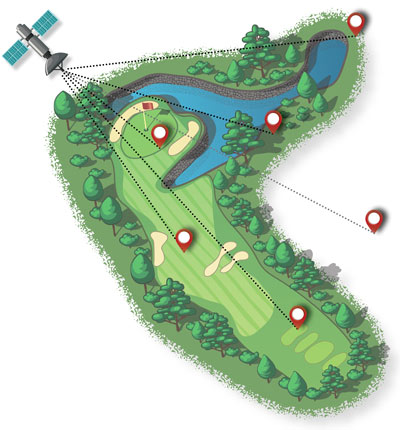
Some GPS history: It is a network of satellites that since 1978 have circled the globe. They were launched as a tool for the U.S. Department of Defense for military applications, and the technology was eventually made available for civilian use in the 1980s. Agriculture was among the first areas to benefit from GPS: Farmers could narrow their target for seeding or irrigation to a fraction of an inch. According to marketing research firm NDP Group, a study eight years ago showed an estimated aggregate benefit of GPS for crop farming totaling $19.9 billion annually. John Deere entered the GPS space 20 years ago on the agriculture side of the business.
Garmin International, a worldwide leader in GPS products and technology, earned more than $3.3 billion in total revenue in 2018 and has sold more than 190 million devices since its inception in 1989. The company’s five primary business segments are automotive, aviation, marine, outdoor and fitness. It makes GPS products for golf, including a laser range finder and smartwatch. Garmin hasn’t entered into GPS technology for golf course maintenance equipment, but ...
“Anything is possible. Right now, we’re focused on consumers,” says Scott Moore, Garmin lead product manager. “One reason we’re seeing more and more uses for GPS is because technology keeps getting better and better and more low-powered, so you can operate something like a sprinkler with less power needs.”
GPS is a force in GCSAA Class A superintendent Sean Reehoorn’s world at Aldarra Golf Club in Sammamish, Wash. “If I have a neighboring homeowner saying we’re spraying their yard and they had an outbreak, I could pull up a map and say I wasn’t even near their property that day,” says Reehoorn, a 15-year association member.
“I think we knew it was coming to this, because farmers were using it, but we didn’t think it’d be cheap enough to use it,” Reehoorn says. “You pay $40,000 for the technology and save $12,000 a year. From an ROI standpoint, after eight years, you can buy a new one without the cost. There’s a safety net with it from time saving, cost saving and security saving. I won’t go back to anything else.”
Still, some see drawbacks. “I’m all for where technology is headed,” says Joel Purpur, CGCS, a 38-year GCSAA member at Park Ridge (Ill.) Country Club. “With high-tech equipment, it could bring high-tech problems. It’s not like old cars where just anybody can just jump under the hood.”
Are equipment managers equipped to troubleshoot GPS products? “If you’re able to operate a smartphone or a computer, GPS should be fairly easy for you. If you have a hard time with technology, you’re probably going to struggle with it,” Tucker says.
Although Steve Wilson, CGCS, superintendent at Milburn Golf & Country Club in Overland Park, Kan., ultimately didn’t purchase a demo sprayer with GPS, he says the manufacturer “bent over backwards” to help fix a problem. A 22-year association member, Wilson says, “We were having trouble with the unit holding a satisfactory lock with the GPS signal. That would cause us to stop spraying and wait for the signal to get back to the level needed. In the end, it was costing us time when our greens sprays are struggling to stay in front of our early morning tee times. From an operational standpoint, the added benefits of more accurate applications and possible chemical savings did not outweigh the lost time.”
On the horizon
Brian Nettz, CGCS, has five Cub Cadet autonomous robotic mowers at Presidio Golf Course in San Francisco. None has GPS capability — but it’s coming. Cub Cadet has implemented RTK GPS on its Infinicut RGX autonomous mowers in current field testing at golf courses, and the company plans to launch the product in January at the Golf Industry Show in Orlando.
“I know they’re anxious to get more technology in our hands,” says Nettz, a 24-year GCSAA member. “It’s something I’m looking forward to.”
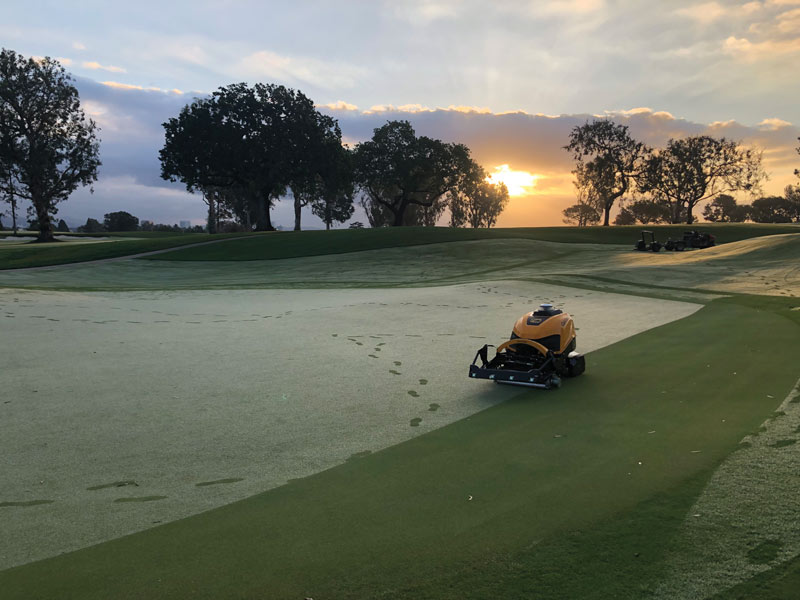
A Cub Cadet autonomous mower in action on a dew-splattered morning at Hillcrest Country Club in Los Angeles. Robotic mowers outfitted with GPS technology are currently being tested. Photo courtesy of Tony Whelan
Labor issues — an industry hot topic — make robotic mowers essential for Nettz. “The efficiency it gives you makes it a no-brainer,” he says. “You get three jobs done at once. The mower is heavy, so actually you’re mowing and rolling at the same time, and you’ve got guys working in the bunkers while it’s mowing. I don’t understand the reticence some people have to adapting to the technology.”
The Toro Co., which has invested in autonomous operation technologies for many years, and Textron Fleet Management (TFM), which has GPS on its Cushman products SprayTek XP and Hauler Pro, among others, are intrigued by the possibilities. “A common message that we hear loud and clear is, resources are constrained, and two resources constrained the most tend to be people and budgets,” says TFM director of products Matt Zaremba, “so a lot of products we come out with look at trying to optimize those two constrained resources.”
John Deere Golf, meanwhile, partnered this year for an exclusive agreement with Precision Makers to develop autonomous mowing solutions. “The golf industry needs more sustainable operating models to maintain precision turf, so expanding the use of technology will be critical to the future success of the industry,” says John Deere product manager Brooks Hastings, whose company features a GPS PrecisionSprayer for use on its ProGator line.
Coming soon: Toro has announced that in 2020 it will offer new technologies that enable machine-to-machine communication between GeoLink-equipped sprayers. This will allow multiple units to work efficiently in concert to apply a spray. If one unit runs out of spray solution, another can seamlessly resume the application in that exact spot. This is possible even after an extended period of time. “We’ve experienced significant interest and growing adoption of GPS-enabled sprayers,” says Tony Ferguson, Toro senior product marketing manager.
In 2017, GCM spotlighted Victoria Golf Club in British Columbia, which was one of five facilities to be main pilot sites for GreenSight Agronomics’ first-generation drone system. Superintendent Paul Robertson saw it as a possible way to eliminate daily soil (moisture) probing by his staff. So how’s it going? “It’s a work in progress. I still believe in the technology,” says Robertson, a 23-year GCSAA member. “I continue to work with them (GreenSight) to reduce our water and pesticide use and to be able to free up resources, including labor.”
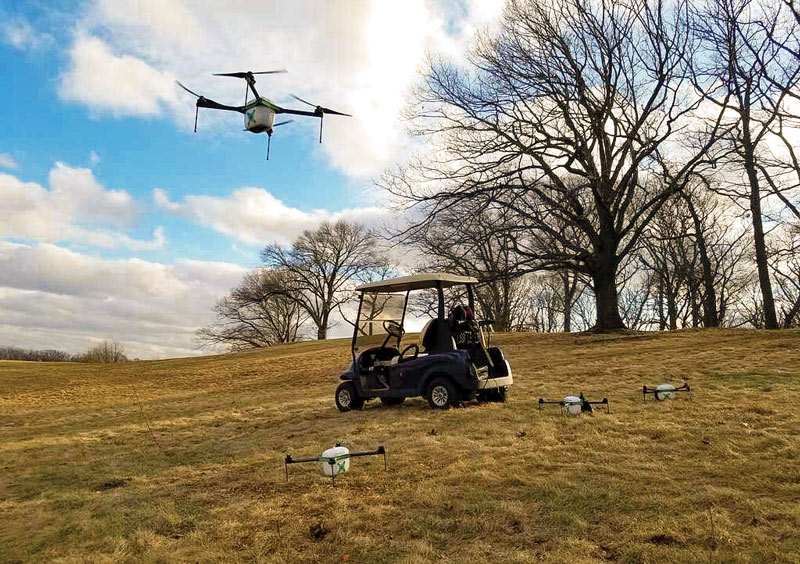
A GreenSight Agronomics’ drone, which includes GPS, in operation during product testing at William Devine Golf Course at Franklin Park in Boston. “It’s another tool in the shop,” says Jason VanBuskirk, who co-founded tech startup Turf Cloud, which was acquired two years ago by GreenSight. Photo courtesy of Jason VanBuskirk
At city-owned Heritage Oaks Golf Course in Harrisonburg, Va., superintendent John Libassi, a 14-year association member, is engaged in talks with his superiors to examine GPS-related options for the next fiscal year’s budget, including an irrigation system upgrade at the course, which experienced three months of drought in 2019. “It’s vital to us to be good stewards of our local environment, especially at times like those, and we try to squeeze out every gallon we can while being as efficient and as mindful as possible in our usage,” Libassi says. “I think it (GPS) is great. Anything to up your game is worth a look.”
If GPS becomes more affordable, there is still no guarantee it would become more attractive for someone like Russell Heller, CGCS, who oversees William Devine Golf Course at Franklin Park in Boston. “I see the potential cost saving in something like a sprayer, but it’s not something I’m able to afford,” says Heller, a 26-year association member whose facility was a test site for a GreenSight drone. “I’m the kind of guy on the golf course all the time, seeing stuff in real time, and don’t need a computer to give me data.”
The first superintendent at Muirfield Village Golf Club in Dublin, Ohio, 76-year-old Ed Etchells, recalls a different era, before GPS, when he earned $1.70 an hour at his first superintendent job in 1962. “They have drones now. When I did this, I had to walk around to see things. Carried sprinklers out with me. Then, walked back to get your mower,” says Etchells, a 53-year GCSAA member. “I can see why they use GPS. It makes sense from an environmental standpoint. And if they’re going to maintain courses with the environment in mind and at levels players desire ... if I was a superintendent today, I’d use it.”
— Howard Richman is GCM’s associate editor.
GPS for water conservation on the golf course
Water use is a significant issue for golf courses throughout the country, and new tools are available to help superintendents make the most of this valuable resource. Using objective data to create soil moisture maps of a golf course’s fairways and taking advantage of valve-in-head control (if applicable) could significantly reduce water consumption if an irrigation system were programmed to match soil moisture variability.
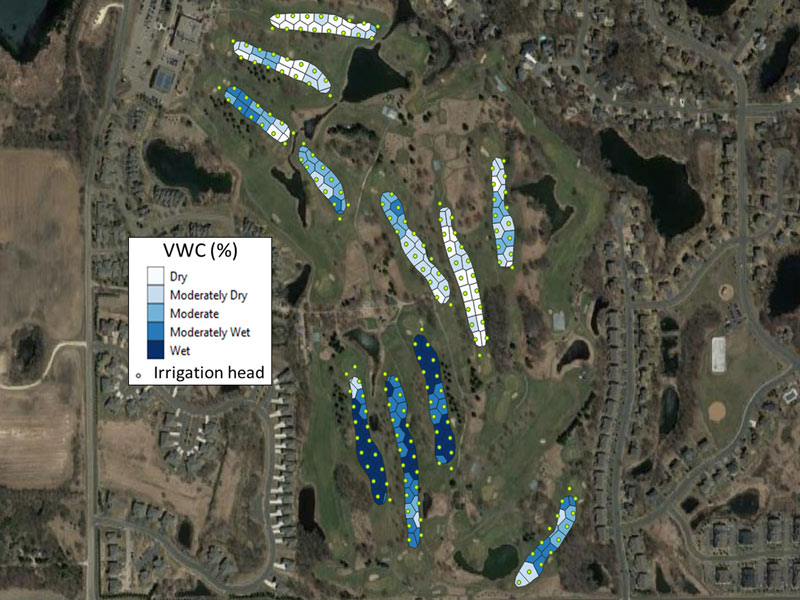
Image courtesy of Chase Straw
The University of Minnesota and the Minnesota GCSA have created a practical strategy to allow golf courses to map fairway soil moisture themselves. The university has developed a protocol for collecting georeferenced soil moisture data with a GPS-equipped soil moisture meter (the FieldScout TDR 350). The data can then be used to create fairway soil moisture maps and irrigation management zones with free mapping software. Using the protocol would allow one person to map an 18-hole golf course in two to three days. Superintendents, staff members, interns, local high school golfers, etc., would all be capable of completing the protocol.
The protocol is applicable to any golf course and can be downloaded without charge. To get started, fill out the Golf Course Soil Moisture Mapping Protocol License.
The University of Minnesota thanks the Minnesota GCSA for its support in developing the soil moisture mapping protocol.
— Chase Straw, Ph.D., is a postdoctoral research associate at the University of Minnesota, and Jack MacKenzie is the executive director of the Minnesota GCSA.
Discover GPS technology at the 2020 Golf Industry Show
Interested in GPS-related products for golf course management? The 2020 Golf Industry Show in Orlando will be the place to see them. As of Oct. 1, here’s who will be exhibiting on the trade show floor at the Orange County Convention Center on Wednesday, Jan. 29, and Thursday, Jan. 30.
• ARAG
• Club Car
• Cub Cadet
• Earth Networks
• ezLocator
• Forestry Suppliers Inc.
• Frost Inc.
• GreenScan 3D
• John Deere Golf
• McDonald & Sons Course Builders Inc.
• Playbooks for Golf
• POGO
• Port Industries
• SGM Industries
• Smithco
• SNA Manufacturing
• Spectrum Technologies Inc.
• Spraying Devices Inc.
• TeeJet Technologies
• Textron Fleet Management
• Thor Guard
• Topcon Positioning Systems
• The Toro Co.
• WILSCOT
• Yamaha Golf-Car Co.